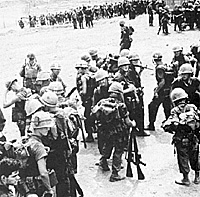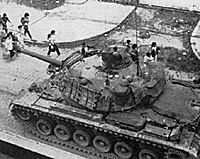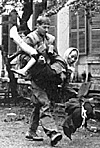
January 30 in Hue was overcast and a slight rain was beginning to fall. Nevertheless, General Truong decided to attend the flag raising ceremony at the Emperor's Gate in the Citadel to mark the coming Year of the Monkey. However, he left early, because a note had reached him telling of attacks on Da Nang, Nha Trang and other cities. General Truong wasn't really worried, but he didn't believe in unnecessary risks either. He resumed to his headquarters and ordered all the divisional staff personnel to report immediately to their posts within the headquarters compound. Also, he canceled all Tet leaves for the remaining ARVN troops within the city. Finally he put in a request to Corps headquarters to get the airborne units back.
The mortar barrage began a little before 3:30 AM. Quickly following it, bright signal flares ordered the poised assault troops of the 6th NVA into action. The airfield was hit hard, and in the brief fire fight there, the fuel bunkers were detonated and blazing fuel lit up the whole city.
Of the eight initial assault battalions, two with mortar and rocket support attacked the MACV compound. One attacked the ARVN 1st Division headquarters. Another one overran the airfield and the remainder were broken into companies which linked up with local VC and were committed to political objectives like the schools, jail, radio station and so forth.
The MACV compound had approximately 300 people attached to it. However only a small part of these were combat troops, the vast majority being administrative personnel. The first assault, launched by the 804th NVA battalion, was beaten back by the defenders, who for the most part were still in skiwies. The second assault was a combined effort by the 803rd and 804th NVA battalions, and this time they had both mortar and rocket support. However, one of their B-40 rockets landed off target and inflicted heavy casualties on one of the attacking companies. After that, the NV A c onten ted themselves with maintaining harrassing fire on the compound only.
Coinciding with the attack on MACV, the ARVN 1st's headquarters also came under siege. However, the attack lacked depth and the headquarters personnel, particularly the Black Panther company, held off the attackers with moderate casualties. It was fortunate that General Truong had recalled all his headquarters people, because the situation would have been very serious if the First Division armory which was well stocked with automatic and crew served weapons had been captured. Truong immediately ordered all his available maneuver battalions back to Hue, and demanded not just two airborne battalions, but the whole brigade.
American Reaction
The first American unit to react was Company A, 1st Battalion, 1st Marines. It was immediately dispatched from Phu Bai at 8:30 A.M. with orders to relieve the MACV compound.
On the way they picked up a tank platoon that had been originally scheduled for transfer to the DMZ. However, before they reached the outskirts of Hue they were ambushed and halted. Fortunately, more reinforcements were coming up from Phu Bai in the form of another infantry company, a 40mm "duster" platoon and a command group. With this added muscle, the ambush broke and by 2:45 they had reached the MACV compound. However, the Marines were still not aware that they were facing the equivalent of an NVA division and they immediately raced across the bridge to attack the Citadel. As soon as they had reached the opposite side, heavy machine gun and recoiless rifle fire inflicted heavy losses and kept them pinned until darkness, when they withdrew back across the river.
Despite the fact that the ARVN 3rd Regiment was only five miles from Hue, it was not until the second day that they managed to reach General Trnong's beleaguered little headquarters garrison. It was obvious that the VC were doing their best to delay any reinforcements.
By February 2 the Marines had been reinforced with two more infantry companies and had secured the general area around the MACV compound. After some consultations with General Truong it was decided that the Marines would clear the south bank, but the Vietnamese would have the honor of liberating the Citadel themselves.
By February 4 the Marine commander, Col. Stanley Hughes, felt he was ready to begin the clearing operation. By this time he had accumulated five companies and he divided them into two strike groups which would attack out from the MACV compound parallel to the river.
 A USMC M48A2 tank moves through Hue to relieve the MACV compound. Refugees are already streaming out of the city. Not all of the civilians could escape to the countryside before the bitter street fighting began, and many were consequently killed and wounded.
A USMC M48A2 tank moves through Hue to relieve the MACV compound. Refugees are already streaming out of the city. Not all of the civilians could escape to the countryside before the bitter street fighting began, and many were consequently killed and wounded.
Meanwhile, the ARVN 3rd was attacking out of the headquarters compound towards the airfield. The NVA put up a heavy, but not overly stiff resistance. Possibly they would've fought harder if they had known that General Truong had been given the full three battalions of paratroopers he had requested and they would be landing as soon as the air strip was free of heavy weapons fire.
By February 7 the airborne had been lifted in and joined the 3rd in the southward push. Reacting quickly, the NVA redeployed their heavy units, along with some fresh troops of the 324th Division that had managed to infiltrate in, and launched heavy spoiling attacks against the paratroopers bringing the ARVN offensive to a halt.
South Bank
However, on the south bank, things were going poorly for the Communists. By the fourth day, many key officers had been killed. Comrade Lam was in command and he could see that the Marines were definitely getting the better of the fighting, particularly since he had received very few of the reinforcements that had penetrated the Allied corridor. On February 4 he asked for permission to withdraw, and received it.
By February 5 most of his troops had successfully disengaged and were moving into the Citadel across the river. However, on February 6 the NVA Command reversed their decision and ordered Lam and his troops back across the river. By February 7 the Marines were re-engaged. But Lam had been forced to change his tactics. Originally, he had fought a gradual delaying action and tried to keep his command together. Now he simply decided to hold-up in key strong points and make no more withdrawals. And while this guaranteed that the two battalions he had left would be completely destroyed, it also guaranteed that the American casualties would be higher, too.
One of the strongest of the new NVA positions was the Quoc Hoc high school, or as the Marines called it "Building 221." It was an imposing masonry structure, whose U-shape gave it excellent fields of fire. For a while Comrade Lam had his headquarters there and the NVA were using it for both a fortress and an armory.
 A Marine gives a hand to an old woman during the street fighting in Hue. Over 100,000 Vietnamese civilians would be left homeless as Hue was destroyed.
A Marine gives a hand to an old woman during the street fighting in Hue. Over 100,000 Vietnamese civilians would be left homeless as Hue was destroyed.
Originally the Marines were using only direct fire weapons, such as small arms, recoiless rifles, and tanks in direct support. But after seeing how well "dug-in" were many of the NVA positions it was decided to use both artillery and CS tear gas. The final irony of the battle of Quac Hoc high school was that very few people on either side realized that it was the Alma Mater of both Ho Chi Minh and General Giap.
Finally, by February 9 all organized NVA resistance on the south bank was finished. Originally Son Lam had felt that if they had held out for seven days his mission would've been a success. He had held out for ten. And now, with only scattered pockets of his troops left he quietly slipped into the surrounding woods, west of Hue.
Citadel Area
With the south bank cleared, General Truong asked the Marines to help in the clearing of the Citadel area. It was decided that the attack in the north would be renewed on February 12, by which time both the U.S. Marines and the newly-arriving ARVN Marines would be deployed for battle.
The Marines quickly moved over to the other side by landing craft while the fresh 1st Battalion, 5th Marines was heliborne in. Then with the U.S. Marines on the left, the remnants of the 3rd and Airborne in the center, and the ARVN Marines on the right the attack continued.
However, in the short lull in the fighting that preceeded the February 12 final attack, the NVA had been busy. Further reinforcements, particularly the 416th battalion of the 5th Division, were now entrenched. Also the extra time had enabled them to turn each individual block into a mini-fortress. Their positions were both well protected and well concealed. And now, despite the overwhelming firepower edge the Allies had, including 8-inch gunfire from an off-shore cruiser, the advance was slow and costly.
Nevertheless, the NVA were having plenty of problems too. On February 16 a lucky artillery round had killed the ranking Communist officer in the Citadel. And his replacement wanted to make an immediate withdrawal before the entire division was destroyed. However, the NVA higher headquarters refused to allow it. The NVA was to fight to the death.
By February 22 all that remained of the enemy-held areas was the Palace of Peace and the surrounding castleworks. At this point the U.S. Marines were pulled out of the fighting. The final assault against the last fanatical resistance would be an all-ARVN show.
This finishing assault against the Palace of Peace took two days of ugly fighting. Neither the ARVN or the NVA gave or asked for quarter. Then, on February 24 a corporal of the Black Panther company climbed to the top of the palace and raised the Vietnamese flag. For General Truong, the battle was over.
Now that the Citadel had been cleared all that remained were the isolated VC hold-outs in the Gia Hoi sector. And this was more a matter of tracking them all down rather than assaulting entrenched positions. Compared to the bitter earlier fighting, it was simply a mopping up operation. The final act in the battle was the discovery, about March 1, of the Hue Massacre, in the "strawberry patch."
Who Won?
The question still remains: who won the battle of Hue? That is very difficult to say. True, the NVA had about 12 battalions completely destroyed in the battle, but the ARVN and Marine casualties had been heavy too. Both the ARVN 3rd and the Airborne Brigade took such heavy casualties that it was a month before they were effective combat units. The 5th Marine Regiment, which contributed most of the Marine battalions in the struggle also needed a rest; many of its experienced non-coms had become casualties in the directing of the house-to-house fighting.
However, the final unanswerable question still remains. Was the political benefit of holding Hue for almost a month worth the complete destruction of a first-class divisional-size unit? Giap, as he would later say, definitely felt it was. So, perhaps the NVA gained a political victory, and the Allies gained a military one.
However, from a wargaming standpoint, a much more relevant question was could either side have handled their troops better than they actually did? Yes, for both sides.
NVA
The NVA in their preoccupation for political targets completely underrated the great advantages that would have been theirs by concentrating more on the military targets within the city. Why only two infantry battalions were assigned to the ARVN headquarters attack is still a mystery. After they had taken the armory there, they could have captured the jail, the schools, radio station etc., at their leisure. Perhaps they felt that two would have been enough since they were supposed to have had complete surprise.
Another point was that they failed to concentrate quickly enough against the individual Allied units as they appeared. The Allies committed their troops piecemeal which was a bad tactic, but the NVA failed to take advantage of it. They had planned the initial assault well, but in their defense failed to establish a good system of priorities. The NVA let the airfield be captured all too easily. And indecision on how long to hold the south bank hurt too. Another point was that too many people were hunting down the political "undesirables" for executions. These men could have been put to much better use against ARVN 3rd when it first ventured out of the headquarters compound.
Allied
On the Allied side, the major mistake was letting the NVA slip a division in completely undetected. But after the NVA were in, they quickly responded by launching the counter-attack. The Allies should not have committed their units in the piecemeal fashion they did, for if they had waited until February 12, when the ARVN Marines had arrived they probably could have blitzed the Citadel and had lower losses overall. Co-ordination between both ARVN and the USMC was superb. So, all in all, one could conclude that strategically the NVA played a better game, but tactically the Allies did the better job.
In retrospect, it is hard to claim either participant as a clearcut winner. But there was a clear-cut loser -- the people of Hue. By the time the fighting was over two thousand had been killed, many by Communist executions, but also many who simply got in the way of the Allied firepower. Over 100,000 were now homeless, with the city in ruins. But both sides declared a "great victory."
John Hill is a relative newcomer to the published field of military history and wargame design. A graduate from Purdue Uniuersity with a B.A. in American Military History, his thesis was the "Tet Offensive, 1968," from which the game Battle for Hue was developed. Last year he designed The B'otherhood for the then just starting CONFLICT GAME COMPANY. He has also designed Verdun, Kaserine Pass, and Overlord and became president of CONFLICT GAMES. Presently he owns and operates the SCALE MODEL SHOP, a military-oriented hobby shop in Lafayette, Indiana.
The photograph that appears on pages 28-29, and those on pages 34, 39, and 40 are official U.S. Marine Corps photos. The photographs on pages 36 and 41 are courtesy of Sgt Larry L. Bishop, who served with the 7th Marine Regiment in I Corps area during the Tet offensive of 1968.
More Tet Offensive
-
Tet Offensive: Introduction
Tet Offensive: US and North Vietamese Strategy
Tet Offensive: Battle for Hue
Tet Offensive: Soldiers
Tet Offensive: Tactical Organization and Equipment
Tet Offensive: Maps: Battle for Hue (very slow: 329K)
Back to Conflict Number 6 Table of Contents
Back to Conflict List of Issues
Back to MagWeb Master Magazine List
© Copyright 1973 by Dana Lombardy
This article appears in MagWeb (Magazine Web) on the Internet World Wide Web.
Other military history articles and gaming articles are available at http://www.magweb.com